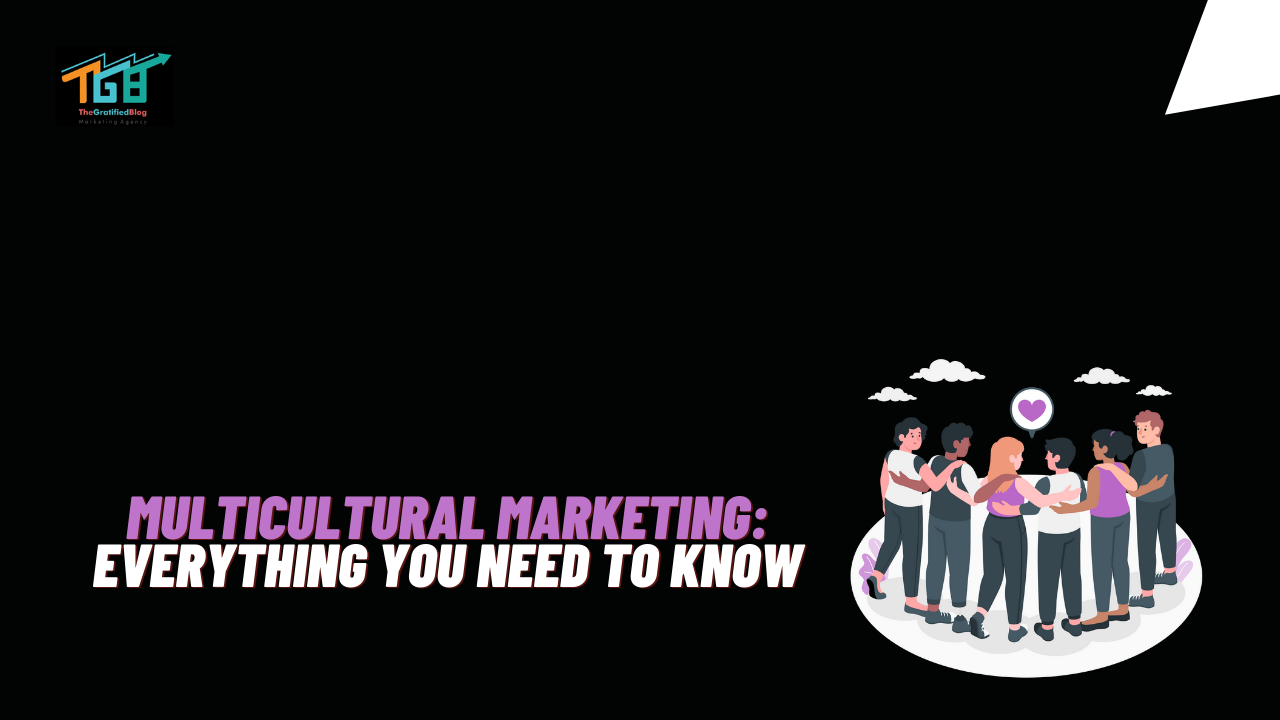
In today’s interconnected world, businesses of all sizes and industries must navigate a global market where diversity and cultural differences are the norms.
This is where multicultural marketing comes into play. One of the biggest challenges businesses face is reaching and engaging with multicultural audiences, particularly those from non-dominant cultural backgrounds.
Multicultural marketing is a strategy that recognises and respects cultural differences and aims to tailor marketing efforts to reach diverse audiences.
This blog will explore multicultural marketing in detail, its advantages, and some tips to successfully implement it in your business strategy.
What Is Multicultural Marketing?
Multicultural marketing refers to tailoring marketing strategies, messages, and campaigns to effectively reach diverse cultural groups within a given population. It recognises various demographic segments’ cultural differences, values, beliefs, and preferences, including ethnicities, races, religions, languages, and lifestyles.
Here are some key aspects and strategies of multicultural marketing:
Cultural Sensitivity: Multicultural marketing requires a deep understanding and appreciation of different cultures, traditions, and customs. Marketers must be sensitive to cultural nuances to avoid unintentional offence or misinterpretation of messages.
Diverse Representation: Brands must feature diverse representation in their marketing materials, including advertisements, imagery, and spokespersons. Representation should reflect the diversity of their target audience to foster inclusivity and resonate with consumers from various cultural backgrounds.
Language Considerations: Language plays a crucial role in multicultural marketing. Brands should communicate with consumers in their preferred language to ensure clarity, connection, and engagement. This may involve translating marketing materials, websites, and advertisements into multiple languages.
Cultural Insights and Research: Conducting cultural research and gathering insights about diverse consumer segments is essential for effective multicultural marketing. Understanding cultural values, traditions, buying behaviours, and media consumption habits can help marketers develop relevant and impactful campaigns.
Segmentation and Targeting: Multicultural marketing involves segmenting and targeting diverse demographic groups based on cultural, linguistic, and ethnic factors. Marketers can create personalised messages and offers that resonate with specific cultural segments to enhance relevance and effectiveness.
Cultural Competence Training: Training and educating marketing teams about cultural diversity, inclusion, and sensitivity are crucial for successful multicultural marketing initiatives. Cultural competence helps marketers navigate cross-cultural interactions, avoid stereotypes, and build authentic connections with diverse audiences.
Community Engagement: Engaging with multicultural communities through events, sponsorships, and partnerships can strengthen brand relationships and foster trust. Participating in cultural celebrations, festivals, and community initiatives demonstrates a commitment to diversity and inclusion.
Feedback and Adaptation: Multicultural marketing requires ongoing feedback, evaluation, and adaptation based on consumer responses and market dynamics. Marketers should be responsive to cultural shifts, consumer preferences, and feedback to continuously refine their strategies and campaigns.
Overall, multicultural marketing enables brands to connect with diverse audiences authentically, drive brand loyalty, and capitalise on the opportunities presented by multicultural demographics in today’s global marketplace.
Why Multicultural Marketing Is Important For Businesses
Multicultural marketing is essential for businesses for several reasons:
- Give Access To Untapped Market
Multicultural marketing has the potential to reach areas where your brand has ready access to a ready and open marketplace with little or no competition.
Access to a ready and eager customer base, most likely waiting for innovative products and services, is a valuable advantage.
The opportunity to capture a significant share of a new market before the competition does is difficult to pass up.”
- Increase Scope Of Innovation
Multicultural marketing benefits businesses because it broadens the scope of innovation. Marketers and brands have more leeway to be creative and inclusive in their campaigns.
They can develop new marketing strategies and test product messaging, such as customised and personalised messages to multicultural customers, to help streamline processes, such as translating messaging into multiple languages.
They can better meet the needs of their target audience by doing so.
- Deeper Market Penetration
Multicultural marketing is essential for businesses because it allows for greater market penetration. By concentrating on specific cultural groups,
Countries like Canada, the United States, and the United Kingdom are home to many different ethnic and cultural groups, and these groups all understand and receive messages differently.
Companies can increase sales and market share in these countries by attracting and serving these groups more effectively.
- Engage Customers In an Appropriate Context
Multicultural marketing is essential for businesses because it allows them to engage with customers in the appropriate context.
Multicultural marketing allows you to fine-tune your marketing efforts so that the message you want to convey resonates in the minds of your target audience, which aids in customer engagement. Do additional research and understand your target audience’s background.
- Reflects Society
Multicultural marketing is essential for businesses because it reflects society’s diversity. We live in an ethnically diverse society;
A more significant number of the population of the United States is multicultural. As our country becomes more ethnically diverse, we must reflect that in our marketing. Brands that appeal to this demographic will benefit from increased awareness and revenue.
Some Of The Best Effective Steps To Create A Multicultural Marketing Strategy
Creating a multicultural marketing strategy involves several key steps:
- Conduct Consumer Research
Conducting cross-cultural consumer research is critical for developing a successful multicultural marketing strategy.
However, if you do not conduct thorough research, your marketing type may fail to address fundamental differences in culture and multicultural segments.
For example, if you distribute a survey in three target markets worldwide but need to notice that 90% of the respondents are from one market, you may end up with strategies that won’t work in two of your markets.
As a result, consumer research should be segmented to personalise targeted marketing to each cultural community you wish to reach.
- Examine Cultural Context, Not Just Language
Understanding your target audience’s cultural context, not just their language, is critical. Language understanding must be more comprehensive to inform an effective multicultural marketing campaign.
Assume you are a new immigrant to North America; you have studied English for many years and are fluent in it. You would still be unaware that discussing politics at the dinner table is culturally inappropriate.
These cultural details may seem obvious to those who grew up with them, but they are not to others when creating marketing campaigns.
- Be Inclusive With Your Team
When developing a multicultural marketing strategy, it is critical to have a diverse team. Your team should reflect the variety of audiences you want to reach.
Your team brings a variety of perspectives, and while you cannot implement every idea that everyone has, strong listening skills and collaborative efforts are critical to keeping your team speaking up and contributing.
Working with different communication styles and soliciting feedback from all team members can help bring unique perspectives and insights that would not have been considered otherwise.
- Involve In Localise Content
It is critical to localise your content to reach different cultural groups effectively is critical. It means adapting your marketing messages to reflect local language, customs, and cultural norms.
It can include, for example, translating your content into different languages and symbols that resonate with different cultural groups and emphasising cultural events or holidays that are important to them.
- Use Inclusive Images & Assets
Using inclusive images and creative assets that reflect your target audience’s diversity is critical.
For example, it allows you to connect with your audience deeper and demonstrate that your brand is inclusive. It includes using images and videos of people from various cultural backgrounds, races, genders, and ages.
People are much more likely to see your product as being for them when your more comprehensive creative assets address the role of your product or service in different cultures rather than images that only show people from a single culture.
- Interact With Ethnic Influencers
Participating in influencer marketing is a powerful multicultural marketing strategy. Collaboration with ethnic influencers is an effective strategy for reaching out to multicultural audiences. These are individuals who have a sizable following on the majority of social media platforms.
The word-of-mouth recommendations of these influencers are widely accepted among their ethnic groups. Consumers from a specific cultural background are more likely to trust the advice of trusted influencers and community members.
Great Multicultural Marketing Examples
Here are some great examples of multicultural marketing campaigns that have successfully connected with diverse audiences:
Coca-Cola – “America Is Beautiful”
Coca-pre-Super Cola’s Bowl multicultural advertising campaign in 2014 is an excellent example of diversity marketing done well.
It features a culturally and racially diverse cast singing a multi-language rendition of “America the Beautiful” to represent America’s changing face.
In the background, different voices sing “America the Beautiful” in various languages. Following its release, the ad became the top trending topic on Facebook following the Super Bowl, and it is a prime example of successful cross-cultural advertising.
Adidas “Here to Create”
“Calling all artists.” The Adidas commercial cuts to a roundtable discussion of well-known and diverse celebrities such as Pharrell Williams, Aaron Rodgers, Lionel Messi, Von Miller, and many more.
In this advertising campaign, Adidas brings masters of their trade to discuss the interplay of creativity and diversity.
“We’re all creators linked by a shared mindset.” It has nothing to do with borders, gender, or race.
We’ve come to create.” And Adidas can successfully tap into this market with this digital marketing campaign.
Conclusion
I hope you understand why Multicultural Marketing is essential and how to create a successful strategy that resonates with diverse audiences.
Whether a small business or a large corporation, these tips can help you connect with a broader range of consumers and increase your sales and revenue.
If you have any doubts about the topic or want to learn more, feel free to get in touch. We will be happy to help you.
Thanks for reading








No Comments